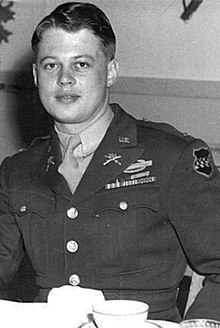Lyle Bouck
| Lyle Bouck | |
|---|---|

First Lt. Lyle Joseph Bouck, Jr.
|
|
| Born | December 17, 1923 Fenton, Missouri |
| Died | December 2, 2016 (aged 92) Sunset Hills, Missouri |
| Allegiance |
|
| Service/branch |
|
| Years of service | 1939–1945 |
| Rank | Captain |
| Commands held | Intelligence and Reconnaissance Platoon, 394th Infantry Regiment, 99th Infantry Division |
| Battles/wars | |
| Awards |
Distinguished Service Cross Silver Star |
| Other work | Chiropractor |
Lyle Joseph Bouck, Jr. (December 17, 1923 – December 2, 2016) enlisted in the U.S. National Guard at age 14. During World War II, he was a 20-year-old lieutenant in charge of the Intelligence and Reconnaissance Platoon, 394th Infantry Regiment, 99th Infantry Division. On the first morning of the Germans' advance during the Battle of the Bulge, his 18-man unit along with four forward artillery observers held off an entire German battalion of more than 500 men for nearly an entire day, killing or wounding 92, and significantly delayed the German advance in a vital sector of the northern front. Every single member of the platoon was later decorated, making it one of the most decorated platoons in all of World War II. Bouck was one of the youngest commissioned officers in the U.S. Army.
Bouck was born in St. Louis, Missouri, the second child of Lyle Joseph and Magdalen M. Bouck. His father, a Private First Class in the U.S. Army during World War I, was a carpenter and Bouck grew up during the Depression and moved frequently with his family. With four siblings, (Robert, Bernice, Eugene and John) they often lived in homes with only one bedroom and no indoor plumbing or electricity. Bouck enlisted in the National Guard at age 14 so he could earn one dollar per drill day to help his family. He was never asked his age. He was rapidly promoted to Supply Sergeant at age 16, making more than most of his civilian friends. At the outset of World War II, when his unit was sent to Alaska, he opted to choose another direction. He volunteered for the paratroop school, Officer Candidate School, or a third option. Officer Candidate School responded first, and Bouck graduated at the top of his class at Fort Benning, doing so well that he was kept on as an instructor.
On December 23, 1940, the 35th Infantry Division was activated for one year of federal duty. His unit participated in the Texas-Louisiana maneuvers of 1941. Bouck was assigned responsibility as transportation sergeant for the regimental Headquarters Company and performed very well. While attending a transportation course, and just before their federal duty was completed, the Japanese attacked Pearl Harbor. Their active duty status was indefinitely extended and Bouck's unit was sent to protect California against a possible enemy invasion. When he was later deployed as part of an advance unit to the Aleutian Islands, he volunteered to attend Officer Candidate School, the newly created Parachute School, or the Army Air Corps. An offer to attend Officer Candidate School arrived first, and Bouck was transferred to Fort Benning, Georgia for four months of intensive training. On his first day there, he was ordered to drill his men. Bouck performed well enough to draw the attention of his commanding officers. He graduated fourth in his class of 57 officers on August 25, 1942. The top ten graduates of each class were retained to teach the next class at Fort Benning, and Bouck was assigned to teach small unit defensive tactics. He spent a year at the school before he was transferred and assigned to the 99th Infantry Division for deployment to Europe.
...
Wikipedia
